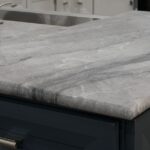While Granite is a widely recognized countertop option for its outstanding durability it’s not impossible for it to crack, normally due to a poor installation. If that has happened to you, know that epoxy can be used to “fix” cracked granite making it look whole again. We will teach you how that can be done in this article.
Fortunately, cracked granite can last a really long time, especially if you can fix the crack early on. Do you want to know some more features of this kind of stone? Then head to our definitive guide on granite countertops!
How cracks on granite can be fixed
Cracks and Breaks on granite can’t really be fixed, what can actually be done is filling the cracks with epoxy or acrylic so that they don’t show.
If it’s a broken piece of granite you want to mend, again, epoxy can be used to glue it together.
After the filling and gluing your granite surface will need to be polished again (actual, power tool, diamond buffing pad kind of polishing).
If that’s done correctly and thoughtfully, it is possible to achieve an almost seamless result, nevertheless, that can never be assured. The process is rather artistic, and a good outcome will depend on how skilled is the person doing it.
Not all cracks need to be repaired
Before you go down the epoxy repair route, it’s important to make sure that’s really necessary. If we’re talking about a crack that doesn’t present any gap, there’s not much to do. As unsightly as any crack is, you can rest assured it will not compromise your granite structure. It might actually be just a fissure (a naturally occurring granite crack).
Now if there’s a gap, then filling this gap with epoxy is for the best.
A good rule of thumb in order to find out which kind of crack you’re dealing with is “If you can feel the crack when you run your fingers through it, then you should fix it”.
How to repair cracks and chips on Granite
We will start by explaining the process of filling a crack on a granite surface. If you’re interested in mending a fully broken piece, that’s the topic of our next section.
Select the epoxy material
Start by selecting the material you will use for the repair. There are many epoxy products created specifically for repairing granite and natural stone. Choose carefully, for some are best for filling cracks, while others are ideal for patching up broken pieces.
Since epoxy is not necessarily colored, you need to think about pigmentation. Some brands offer pigments to mix to their epoxy in order to make them look similar to your granite variety. Choose carefully,
We favor a slightly different coloring approach, as we will explain on the next subsection.
Collect granite dust
In order to reach the desired color, granite dust can be mixed together with the epoxy for pigmentation. Ideally you should collect granite dust ground from a slab that’s very similar to yours.
Beveling granite edges and polishing, a very common activity for countertop fabricators and installers, generate lots of granite dust, optionally you can try to buy the amount you need from these professionals.
2 teaspoons of granite powder should be more than enough for 1 foot long crack, so maybe you can even get that for free.
Clean up and isolate the crack area
Thoroughly clean the crack area with acetone, and use painter’s tape to isolate an area of at least ⅛ inch around the whole crack. This will help you clean up the remaining epoxy later.
Prepare the epoxy mix
Mix the epoxy, normally a 2-part mix, according to the directions of the supplier, then add granite dust until the paste is the same color as the granite you’re repairing.
Apply the epoxy on the crack
Apply the epoxy using the same tool you used for mixing, pushing it into the crack until it is filled.
The trick here is ensuring the crack is filled while guaranteeing a smooth application. Remember all excessive epoxy will need to be polished down later. However, do remember epoxy tends to shrink, so over filling is better than under filling.
Wait for the epoxy to dry
Give the epoxy time to dry completely, as much time as required by the manufacturer.
Finishing
After everything is done, the granite surface needs to be polished again. This is to sand down the epoxy “scar” and make the whole surface look like one again.
We will discuss polished on the last section of this article.
How to reattach broken granite pieces
As discussed, fixing granite cracked pieces is a matter of mending them together with epoxy.
The first steps of the process are exactly the same as those described in the last procedure, with few minimal adaptations.
Select the epoxy material
Start by selecting the material you will use for the repair. There are many epoxy products created specifically for repairing granite and natural stone. Choose carefully, for some are best for filling cracks, while others are ideal for patching up broken pieces.
Since epoxy is not necessarily colored, you need to think about pigmentation. Some brands offer pigments to mix to their epoxy in order to make them look similar to your granite variety. Choose carefully,
We favor a slightly different coloring approach, as we will explain on the next subsection.
Collect granite dust
In order to reach the desired color, granite dust can be mixed together with the epoxy for pigmentation. Ideally you should collect granite dust ground from a slab that’s very similar to yours.
Beveling granite edges and polishing, a very common activity for countertop fabricators and installers, generates lots of granite dust, optionally you can try to buy the amount you need from these professionals.
6 teaspoons of granite powder should be more than enough for each foot of the broken area length.
Clean up and isolate the crack area
Thoroughly clean the crack area with acetone, and use painter’s tape to isolate an area of at least ⅛ inch around the whole broken area. This will help you clean up the remaining epoxy later.
Remove all dust remains and debris from the broken areas since they will prevent proper gluing of the 2 parts together.
Check whether the broken section will require increased supporting
Most of the time sections of granite crack and break due to too much overhang with poor supporting. If that was the case, you need to get that fixed so that during and after the repair everything is properly supported.
Proper support for overhangs is normally achieved by using an angle bar or L shaped bracket.
Prepare the epoxy mix
Mix the epoxy, normally a 2-part mix, according to the directions of the supplier, then add granite dust until the paste is the same color as the granite you’re repairing.
Apply the first coat of epoxy
Use the same tool you used to mix the epoxy to apply it to each of the surfaces individually first. Then stick them both together pressing it against each other. Epoxy will begin to ooze out of the joint area, clean it off with a rag.
Ensure proper leveling
Use shims to ensure that both the original surface and the broken piece are perfectly leveled. If it needs more support, tape it with more painter’s tape.
Wait for the first coat of epoxy to dry
Make sure no one touches the repaired area for the amount of cure time specified by the contractor. Normally a day or two.
Apply the second coat of epoxy
Now, since most epoxy shrinks as it dries, there will be a slight deppression to fill at the joint area. If so, you will need to apply a second coat of epoxy.
Repeat the same procedure used for filling a crack in order to get the surface as smooth and flat as possible.
Wait for the second coat of epoxy to dry
Give the epoxy time to dry completely, as much time as required by the manufacturer.
Finishing
After everything is done, the granite surface needs to be polished again. This is to sand down the epoxy “scar” and make the whole surface look like one again.
Last step: Polishing
We’ve come to the last step of our how to fix cracked granite step-by-step guide.
In order to make your granite surface look whole again, the repaired area will need to be polished. And we’re not talking about using a chemical product, we are talking about polishing with high speed diamond buffing pads.
In order to get a full step-by-step guide of how to polish granite countertops, read our complete article “How Granite is Polished”.
Is fixing cracked granite DIY?
While it’s not impossible to do it all at home, fixing cracked granite is not only time-consuming, it’s also very hard to do it right the first time.
Now when you consider the cost of renting or purchasing polishing equipment, it simply becomes unreasonable not to call in the pros.
Look for stone repair professionals in your area to help you, that’s your best shot at a seamless repair and will ensure much less headache.
If you live in Sarasota or surrounding cities, don’t hesitate to call our experts at Eagle Stones.



